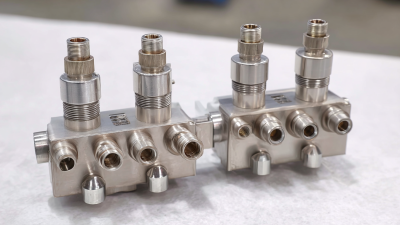How to Select the Right Small Pneumatic Valves for Enhanced System Performance
In the realm of industrial automation, the selection of the appropriate components significantly influences operational efficiency and reliability. One critical element in this puzzle is the use of small pneumatic valves, which play an essential role in controlling fluid power systems. According to a recent report by the International Pneumatics Association, the global market for pneumatic valves, including small pneumatic valves, is expected to grow at a CAGR of 6.5% from 2023 to 2030, driven by the increasing demand for precision and automation across various sectors. These compact valves not only enhance system performance by providing faster response times and improved energy efficiency, but they also contribute to the overall reduction of operational costs. As industries continue to evolve and emphasize productivity, understanding how to select the right small pneumatic valves becomes paramount for engineers and decision-makers striving to optimize their systems.

Understanding the Basics of Small Pneumatic Valves and Their Applications
Selecting the right small pneumatic valves is crucial for optimizing system performance in various applications. Understanding the fundamentals of these valves involves recognizing their role in pneumatic motions, which continues to be a mainstay in modern automation due to advancements in intelligence and sustainability. Recent trends indicate that manufacturers are turning to electrically actuated pneumatic cylinders, as they significantly reduce setup times, especially when producing complex parts from materials like wood and aluminum in small batches.
**Tip:** When selecting small pneumatic valves, consider their compatibility with your system's specific needs, such as pressure ratings and flow characteristics. Valves that incorporate piezoelectric technology can enhance precision and efficiency, providing better control for advanced applications.
Moreover, the versatility of small pneumatic valves extends to various industries, including life sciences, where automation solutions require both accuracy and compactness. As industries evolve, selecting the appropriate valves not only impacts operational efficiency but also contributes to sustainability goals by reducing waste and energy consumption.
**Tip:** Always assess the application requirements and explore the latest technologies available in pneumatic control to ensure optimal system performance.
How to Select the Right Small Pneumatic Valves for Enhanced System Performance
| Valve Type | Operating Pressure (bar) | Port Size (mm) | Flow Rate (l/min) | Temperature Range (°C) | Application |
|---|---|---|---|---|---|
| General Purpose Valve | 1-8 | 6 | 300 | -5 to 50 | Automated Systems |
| Poppet Valve | 1-10 | 8 | 500 | -10 to 60 | Pneumatic Tools |
| Solenoid Valve | 1-7 | 4 | 250 | 0 to 40 | Process Control |
| Angle Seat Valve | 2-8 | 10 | 800 | -5 to 65 | Water Treatment |
Key Factors to Consider When Choosing Small Pneumatic Valves
When selecting small pneumatic valves, several key factors play a crucial role in ensuring optimal system performance. First and foremost, the valve's flow characteristics must align with system requirements. According to a report by the International Society of Automation, valves with optimal Cv (flow coefficient) ratings can enhance overall efficiency by up to 15%. It is essential to assess the flow rate and pressure requirements of the application to ensure the chosen valve can handle the desired parameters effectively.

Another critical aspect to consider is the material compatibility with the media being controlled. Many industries utilize pneumatic systems where chemicals, humidity, or temperature variations can affect the material over time. Research by the Fluid Power Journal highlights that using the appropriate material can extend valve life significantly, sometimes by as much as 30%. Selecting valves made from corrosion-resistant and durable materials not only mitigates potential failures but also enhances the system's reliability and longevity.
The Impact of Valve Design on System Performance and Efficiency
The design of pneumatic valves plays a critical role in determining the efficiency and overall performance of pneumatic systems. When selecting small pneumatic valves, factors such as flow characteristics, response time, and operating pressure must be carefully considered. Valves with a streamlined design can significantly reduce pressure drops and improve response times, which is essential for applications that require quick actuation and precise control. Additionally, materials used in valve construction can influence durability and performance, particularly in environments exposed to corrosive substances or varying temperatures.

Moreover, the configuration of the valve, whether it be a direct-acting or pilot-operated type, can affect system efficiency. Direct-acting valves are typically more responsive, making them suitable for applications that demand instant control. In contrast, pilot-operated valves can handle higher flow rates with lower energy consumption, which is advantageous for larger systems. By understanding the impact of these design elements, engineers can optimize their selections, leading to improved operational efficiency, reduced energy costs, and enhanced reliability in pneumatic systems.
Ultimately, a well-chosen valve not only elevates performance but also extends the lifespan of the entire system.
Common Materials Used in Small Pneumatic Valves and Their Benefits
When selecting small pneumatic valves, understanding the common materials used in their construction can significantly enhance system performance. The most prevalent materials include brass, stainless steel, and plastic. Brass valves are favored for their durability and corrosion resistance, making them an excellent choice for most industrial applications. They handle high pressure well and provide long service life, which is crucial for maintaining efficiency in pneumatic systems.
Stainless steel, on the other hand, is ideal for environments that demand high resistance to corrosion and wear, particularly in applications involving harsh chemicals or high temperatures. Its strength and longevity ensure that valves maintain their integrity over time, thereby reducing maintenance costs.
Lastly, plastic valves offer lightweight and cost-effective solutions for less demanding applications. They are particularly beneficial in systems that require ease of installation and weight savings, but they may not withstand extreme conditions as effectively as metal counterparts. Understanding these materials can help you make informed decisions tailored to the specific needs of your pneumatic systems.
Tips for Testing and Evaluating Small Pneumatic Valves Before Purchase
When considering the purchase of small pneumatic valves, it is essential to conduct thorough testing and evaluation to ensure optimal performance in your system. Start by assessing the valve's flow capacity, as this directly affects how efficiently it can operate within your specific application. Use flow meters to measure the rate at which air passes through the valve under various pressure conditions. This will help you determine if the valve can handle your system's demands without causing restrictions or inconsistencies.
Another critical aspect to evaluate is the valve's response time. You can achieve this by simulating operational conditions and measuring how quickly the valve opens and closes. A slower response can lead to inefficiencies and affect the overall system performance. Additionally, take the time to review the valve's build quality and materials, as they directly influence reliability and lifespan. Ensuring that the valve can withstand the pressure and environmental factors specific to your application will help prevent future failures and maintenance issues. By focusing on these key testing parameters, you can make a well-informed decision and select the right small pneumatic valves that enhance your system's performance.
Related Posts
-

Exploring Innovative Alternatives to the Best Small Pneumatic Valves for Your Industrial Needs
-

2025 Market Trends in Pneumatic Valves for Global Buyers
-

7 Effective Tips to Optimize Pneumatic Flow Valve Performance
-

7 Essential Features of Small Pneumatic Valves You Should Know About
-

Mastering Pneumatic Flow Control Valves A Comprehensive Guide for Global Buyers
-

7 Compelling Reasons to Choose Industrial Control Valves for Your Global Sourcing Needs
